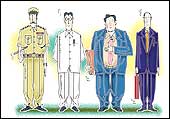|
 Industry's
first managers were authoritarian. The owner's only concern was
profits, and he gave a free hand to his managers on the shopfloor.
And since there were few regulations, the managers did what they
pleased. By the end of the 40s, organisations had become much bigger.
The number of workers went up considerably, and managing them needed
systems. Companies hired more managers to deal with that, but their
management scope was limited. One manager would typically oversee
only four or five officers and about 10 to 12 clerks. Simultaneously,
the Factories Act of 1948 defined the worker rights and the employer's
obligations towards him. This gave rise to the administrative style
of management. The manager was still the boss, but now he had a
rule book to thrust in the face of the worker. Industry's
first managers were authoritarian. The owner's only concern was
profits, and he gave a free hand to his managers on the shopfloor.
And since there were few regulations, the managers did what they
pleased. By the end of the 40s, organisations had become much bigger.
The number of workers went up considerably, and managing them needed
systems. Companies hired more managers to deal with that, but their
management scope was limited. One manager would typically oversee
only four or five officers and about 10 to 12 clerks. Simultaneously,
the Factories Act of 1948 defined the worker rights and the employer's
obligations towards him. This gave rise to the administrative style
of management. The manager was still the boss, but now he had a
rule book to thrust in the face of the worker.
Public sector undertakings in the 50s and 60s
brought a laid-back style of management. Employees were rarely set
up with steep challenges, and indulgent benevolence became the norm.
With the state policing industry, paper work and bureaucracy became
the buzzword. Since the bureaucrat's power was almost absolute,
he tended to be like the 1920s authoritarian manager. This kind
of management by bureaucracy continued through the 80s.
With the 90s came the professional managers.
Globalisation and privatisation internally opened up new industries,
and as Indian groups scrambled to invest, they needed managers who
could function as de facto owners. Besides, technology changed rapidly.
Suddenly, the manager had to become a facilitator.
Dressing Up Salarymen
 |
| Steel factory workers on their way to work |
G.D. Birla liked
to see his managers clean-shaven and in suits. But Birla was more
an exception than the norm. While some progressive Indian promoters
themselves liked to dress up nattily, they rarely imposed any dress
code on their employees. That meant the office-goer could wear pretty
much what he wanted. Yet, like it happens even now, there were sartorial
fads that came and went. The preferred attire from the 20s to the
40s was the dhoti and blazer combination. In the 50s, when India
corporations started looking westward, suits, pointed leather shoes,
and thin ties became fashionable. The following decade, however,
brought a wave of socialism, and the dress code of the day-white,
pleated trousers and short-sleeved white shirts-reflected that spirit.
The 70s proselytised private enterprise to the religion of the state
and, therefore, the safari suit emerged as the babu's sartorial
staple.
The past two decades-especially the 90s-saw
major upheavals in professional clothing. The rise of information
technology stood corporate dressing rules on their head. While software
companies and dotcoms slipped into jeans and sneakers, even the
pin-striped bankers and marketers took to more casual dressing.
Away from the offices, the worker's dress code-except in some industries-went
unregulated. The two Factories Act of 1891 and 1948 only sought
to make the workplace safer for the worker, without prescribing
any dress code. But some big manufacturing companies laid down their
own rules not only to increase work safety, but also to build a
sense of camaraderie. To the executive, clothes were what made him.
Today, it is even more so.
The Board Through The Ages
 |
| Tata Steel's Dorab Tata (seated middle) with
other directors |
Because money was
usually raised from within the promoter community, the early textile
mills of Bombay were run by 'managing agencies' (often the principal
promoter was the manager), which received a commission on the mill's
assets and sales, and later only on profits. The board, which comprised
all the other major shareholders, only had titular powers. By 1951,
there were some 36 managing agency firms-including the Birlas, Dalmias,
Singhanias, and the Tatas-controlling more than 600 industrial concerns,
most acquired from departing Britons.
Licences and quotas forced companies to expand
via hundreds of small units controlled through a maze of cross-holdings.
In 1969, the government banned the managing agency system. Instead
three categories of management were allowed: Direct management;
management by board; and indirect management, via a managing director
and whole-time board of directors. While the amendment succeeded
in changing the management structure, it did nothing to rid the
system of either cross-holdings or favouritism on the board.
Liberalisation changed that. With restrictions
gone, companies could consolidate their holdings, not just for size,
but also to protect against takeovers. More business-friendly norms
on inter-corporate investments, and taxes on direct investments
have made it easier for groups to unravel their cross-holdings.
New norms on corporate governance have now delineated responsibilities
among three stakeholders: the shareholders, the board of directors,
and the management. The party, as they say, is over.
An Old Contract Expired
 By
virtue of being family-owned and managed, most Indian companies
have been very personal. The key executives in them were either
the promoters themselves or their kith and kin-people they trusted.
Therefore, spelling out the terms of their employment contract was
not necessary. The business was theirs, and they expected to be
part of it as long as they lived. By
virtue of being family-owned and managed, most Indian companies
have been very personal. The key executives in them were either
the promoters themselves or their kith and kin-people they trusted.
Therefore, spelling out the terms of their employment contract was
not necessary. The business was theirs, and they expected to be
part of it as long as they lived.
The same was true of the non-family employees
they hired. Employment, implicitly or explicitly, was for lifetime.
Jobs were transferable within the company and the group, but no
one was ever in danger of getting fired or laid off. That happened
only in cases where misconduct or disloyalty was suspected or proved.
Still, there was tremendous amount of animosity between the owners
and the workers. The former were seen as greedy capitalists who
were enriching themselves at the cost of poor workers. That strengthened
the trade union movement, and in the 70s and 80s, it became a powerful
force, setting the terms of employment for the worker.
Partly in a bid to break that and partly in
response to stiffer competition, companies in the 90s started offering
contractual employment. On paper, the employee was hired for a fixed
period, although in reality employment was assured as long as the
person delivered. Once again, it companies, because of their unique
business environment, ushered in new kinds of employee engagement
terms, which others have now cottoned on to.
In return for more money, employers earned
themselves the flexibility of hiring and firing white-collar workers
(blue-collar rules are still complicated). One thing that became
apparent in the 90s-especially towards its end-was the death of
job security. A new market for talent had arisen. And, as the decade
came to an end, it was looking more and more like the auction system.
The Organisation's
Jargon
BT takes an irreverent look at the jargonaut that steam-rolled
plain English.
Angels: Technology entrepreneurs giving
a start-up its seed capital
Attention Economy:
Money comes when customers listen
Benchmarking:
How organisations better the Joneses
Buy In: It's
the age of consensus. No agreement, no win
Core Competence:
Do what you are best at. Junk the rest
Change Management: You missed the bus.
Now fix the mess
Differentiation: This is what an organisation
with attitude does
Disintermediation: Know the middleman?
Well, he just died
Downsize: You hired just too many morons.
Time to let go
E: Once the most popular prefix, robbed
millions of investors
Empowerment: A polite way of stopping
the buck down below
Flat Organisations: Where the fat middle
walked the plank
Globalisation: Men, markets, and money
could be anywhere today
Intellectual Capital: The sum of what
your best brains know
Leverage: Companies waking up to the
Archimedes' Principle
Mass Customisation: Letting your customers
do their own things
New Economy: The rise of technology
as a business driver
Outsource: How companies get rid of
essential but dirty work
Paradigm Shift: When business models
fly out of the window
Reengineering: Reassembling your firm
into something better
Stakeholder: Today, even the dog outside
your factory is one
Synergy: An excuse for fooling around
with your business
Value Proposition: Where logic fails,
money may actually win
Virtual: It exists, but it doesn't...
like your profits
|

